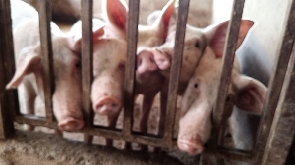Correspondence from the Eastern Region
About 170 pigs – that is the size of the herd of the piggery at the D’yeki Eco Village, an average swine-producing farm located at Odumase-Krobo in the Eastern Region. The farm owners have spent the last one and a half years establishing the piggery – and have not finished yet with extensive ongoing expansion to triple its current size in the next few years.
Although the farm may have dodged a bullet in having no cases of any of the dreaded swine diseases, managers of the facility continue to exercise caution to avoid other fatalities.
From an initial number of 15 sows and 2 boars, the piggery now boasts of 170 pigs including 38 sows, three boars and in just one and a half years.
Describing pig farming as a goldmine in terms of its profitability, Mr. Worlali, Martin farm manager at the D’yeki Eco Village which also undertakes fish farming, poultry rearing, goat production and crop farming said a farmer has the potential to see his animals multiply rapidly within a relatively short period to enable him to reap bountifully.
“Piggery is very profitable; I think we’re sitting on a goldmine. As a farmer who does pigs, you can earn quite a lot from the piggery,” said the farm manager, attributing the profitability to the high birth rate and high cost of pork.
With the sows maturing for crossing by 6 to seven months old and farrowing an average of ten piglets at a time up to three times in a year, the numbers rise rapidly within a few years.
The pigs are either sold live or slaughtered for its customers. At its slaughterhouse, it receives and processes orders for patrons who request the meat for various reasons.
With the ever-rising cost of feeding, this particular farm prepares the animal feed based on its own formula. This consists of ingredients such as maize, soya bean, palm kernel cake (PKC), limestone, wheat and rice bran, as well as some concentrates for the animals
Despite the cost of feeding, medical, structure, power and other expenses required as a start-up for pig farming, Mr. Worlali describes beginning a piggery as “a bit capital intensive,” largely because after the setup, the only remaining expense is feeding which is also largely supplemented by other cost-free foods.
Though the animals occasionally suffer births and diseases such as dysentery, worm infestation and minor injuries, these do not threaten the production as these only rarely happen.
The farm currently has one permanent worker responsible for cleaning the sites and feeding the animals but with ongoing expansion works, more workers are likely to be employed on the farm.

While describing pig production as lucrative, the farm manager urged the youth to consider venturing into the trade to serve as a reliable means of employment. He said, “Pigs is very, very profitable… if you start with just one sow and one boar [productivity would rise in a short time],” he said.
According to Mr. Worlali, the price of a pig is determined by its dead weight (its weight after being slaughtered) which averages the prices of fully grown pigs to between GH₵2000 to GH₵2,500.
The future target for the piggery, the farm manager detailed, is to produce some 500 pigs a year for the market out of its brooder stock.

Business News of Wednesday, 9 August 2023
Source: www.ghanaweb.com
Pig farmer recommends piggery as a lucrative farming business
Entertainment
















